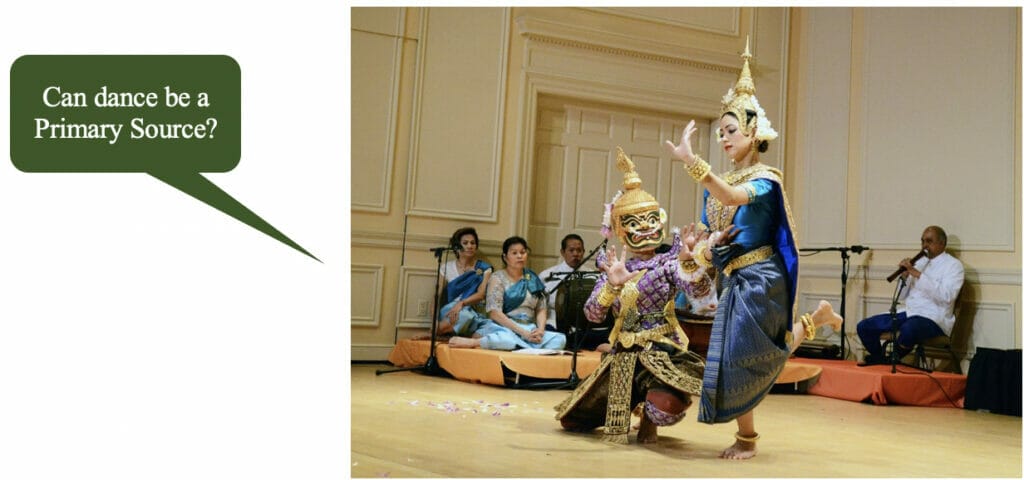Teaching with Folk Sources offers an inquiry-based set of lessons and learning activities. We define some frequently used terms highlighted in green throughout this introduction.
Ethnography: A study of culture and cultural processes that uses multiple ways to research, observe, and document people, places, events, and artifacts.
Oral History: Both a method and an ethical framework used to access lived memories or individual and community understanding of cultural ways of life. Oral history refers to the process of documenting these perspectives through a loosely structured interview format and the resulting recorded media.
Primary Source: In addition to historical documents, a primary source includes contents of ethnographic and folklife collections such as photographs, recorded and transcribed interviews, artifacts, recipes, music, maps, and more.
Over the past 150 years, folklorists, ethnomusicologists, and other cultural researchers have created a unique and enormous corpus of ethnographic folklife collections: multi-format, unpublished archival collections that contain irreplaceable records of the life of our country. Such collections are created works, brought together through the intentions and activities of the researcher, often working in collaboration with members of the community whose traditional expressive life is the focus of study. Oral histories and ethnographic materials help present complicated issues and topics by comparing and contrasting life experiences, voices, and vantage points. Although they do often reflect historical truth, primary sources are valued as powerful reference points for understanding individual and community perspectives on memory, meaning, and identity. The largest and most significant collection of these materials in the United States is the Archive of the American Folklife Center at the Library of Congress, but similar, smaller collections are held by individuals, organizations, and academic institutions across the U.S.
Learning Activities and Lesson Planning Tools—The 6th “E”
The Lesson Plans in this guide follow the 5E model for instruction: Engage, Explore, Explain, Extend/Elaborate, and Evaluate. Folk Sources offer a 6th “E” that introduces a specialized research methodology that cultural anthropologists, folklorists, and other qualitative researchers use: Ethnography.
Ethnography literally means to “write culture.” Folklife, traditional arts, and community stories are artistic expressions shared among groups that are meaningful for a cultural community and have been shared informally, often for generations. Importantly, ethnography uses interviews and documentation as research tools to learn information directly from members of our communities that might not be in a published book or searchable online.
The primary sources used throughout this guide are sourced from materials created by the methods of ethnography and oral history. Exploring the collections of the American Folklife Center at the Library of Congress one will find records of American life gathered through these qualitative methods. Understanding the method offers insights for all of us, and critical learning opportunities for students–from elementary and through graduate school.
Stop and Reflect Activity

The Cambodian-American Heritage Dancers and Chum Ngek Ensemble perform at the Library of Congress in 2017. Photo by Stephen Winick. https://blogs.loc.gov/folklife/2019/05/homegrown-plus-cambodian-american-heritage-dancers-with-chum-ngek-ensemble
Strategies
1. Observe
What details do you see in the dance movement? Costume? Music? Gestures?
2. Analyze Context
Is there an audience that knows how to “read” this performance as text?
Is there a community for whom this dance serves as a telling of history or community practice? (Tip: The caption might have additional clues.)
3. Reflect
Do primary sources have to be items in an archive to be primary sources? If not, where else might we discover primary sources in our communities? In our homes?
We have created teaching units in this guide that can be engaged sequentially for a scaffolded learning experience that moves students from Process (interviews, documentation, and art) to Product (learning through listening, observing, reading primary sources) to Analysis (challenging history and primary sources). However, each class may also develop their own pathways through these assignments, using the essential questions and topics to inform their lessons.
Examples of assignments and activities that feature Process are those that center research methodologies from ethnography and oral history, including documentation and interviews (see especially lessons in Units 1 and 2).
We define Products to include the many kinds of items that can be found in an archive, as well as the secondary sources that are created for users and audiences of many types, including students, museum goers, and community participants.
Lessons that center Analysis hone students’ tools for interpretation, critical thinking, and considering essential questions that connect to education standards for many subjects (see especially lessons in Unit 5—Challenging History).
By way of orientation, we offer these notes on the Teaching with Folk Sources Curriculum Guide:
Key Terms
- Visual Literacy
- Aural Literacy
- Textual Literacy
- Cultural Literacy
- Multiple Perspectives
- Compare/Contrast
Essential Questions
These questions shaped the creation of Folk Sources:
- How can primary sources created or archived through an ethnographic research process support developing multiple types of literacy?
- What role can identity play in decoding or understanding texts?
- What are the limitations to “perspective taking” when it comes to primary sources from a time, community, or place that is unfamiliar?
- How do assumptions such as personal beliefs and opinions intersect with the creation of any primary source, especially those grounded in ethnography?
Content Focus Areas
- History
- Access
- Art
- Cultural Studies
- English Language Arts
- Equity and Inclusion
- Geography
- Civil Rights
- Civics
- Information Literacy
- Library Studies
- Media Studies
- Literacy
- Research
To illustrate Unit 1, Lesson 1, the linked Classroom Connections in the left sidebar offers an introduction to the Teaching with Folk Sources project that can also be adapted for different grade levels and content areas.
URL
American Folklife Center https://www.loc.gov/folklife
